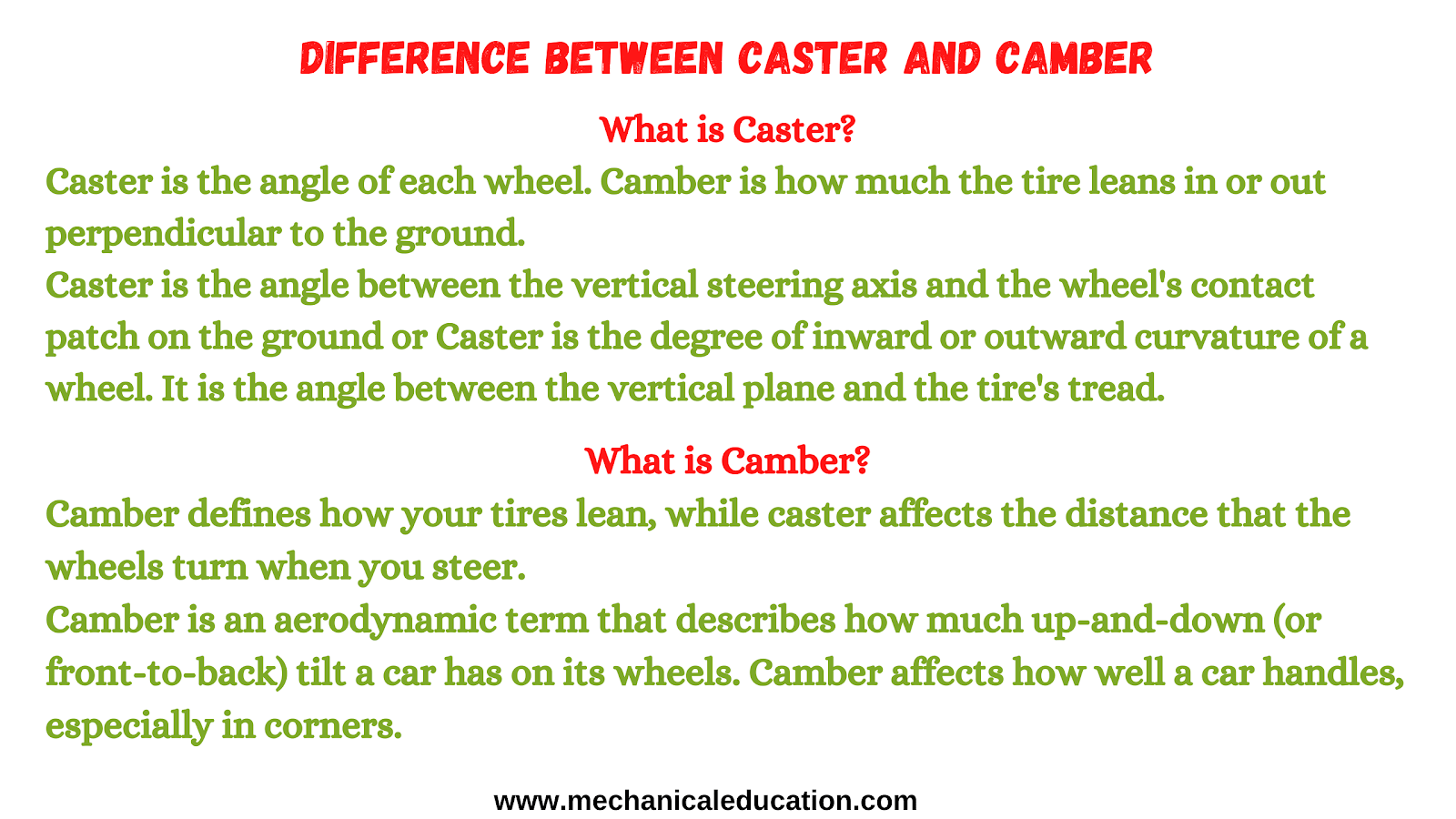Difference between Caster and Camber
What is Caster?
Caster is the angle of each wheel. Camber is how much the tire leans in or out perpendicular to the ground.
Caster is the angle between the vertical steering axis and the wheel’s contact patch on the ground or Caster is the degree of inward or outward curvature of a wheel. It is the angle between the vertical plane and the tire’s tread.
Caster is the most common type of wheel and it is usually a metal disc that can be moved in any direction to control steering.
Caster doesn’t have as big an effect on tire wear, but it does play a role in how well a car handles.
Caster is a term used to describe two different things depending on which context it’s used in. In motorcycle and car terminology, caster is a parameter that affects steering geometry and describes how much a wheel leans in towards or away from the vehicle’s centerline when steered.
What is Camber?
Camber defines how your tires lean, while caster affects the distance that the wheels turn when you steer.
Camber is an aerodynamic term that describes how much up-and-down (or front-to-back) tilt a car has on its wheels. Camber affects how well a car handles, especially in corners.
Camber is the angle between a vertical plane through a wheel’s tire and the ground.
Camber is the inward or outward tilt of a wheel’s vertical axis as it rotates around its axle.
A camber wheel is one where the height of the outer edge (also known as toe) changes as you move towards or away from the centerline of the vehicle.
Camber has a bigger effect on tire wear because it determines how much weight is placed on each tire. Too much camber (when one side of the tire is higher than the other) can cause uneven tire wear, while too little camber (when both sides of the tire are equally high) can lead to poor handling and reduced grip.
Camber is the inward or outward tilt of the wheels, measured in degrees, from the vertical. Positive camber means the top of the wheel is tilted outwards from the car (away from the center of the car), while negative camber means that it’s tilted inwards.
Different between Caster and Camber?
Caster is the angle formed between the vertical steering axis of a wheel and its projection onto the ground. Camber is the angle formed between the wheel’s vertical axis and the plane perpendicular to it.
Caster is responsible for how self-centering a wheel becomes as it moves forward. Camber does not have this effect.
Camber affects tire wear, while caster does not.
Camber is more important than caster when it comes to car handling and tire wear. In some cases (especially when using low-profile tires), the caster can become more important.
Camber affects how a wheel handles bumps and how it drains water away from the tire contact patch. Too much camber can cause a car to be unstable, especially when cornering because one side of the tire will be doing most of the work. Camber can also wear tires unevenly, cause them to heat up more in one spot, and make them more likely to hydroplane on wet roads.
Caster affects how easily a wheel turns and how stable it is.
Caster is the angle between the vertical and horizontal axes of a vehicle’s steering knuckles. A caster angle of zero degrees is called neutral, and it corresponds to straight tracking with no toe-in or toe-out. A car with zero caster would be perfectly flat, while a car with a positive caster would have a slight upward curvature.
Camber refers to how far one side of a wheel leans inward or outward from its vertical axis in relation to the other side. When viewed from above, camber describes how much higher on one side than the other a wheel’s outer edge sits relative to its inner edge when measured at its center. Camber angles are typically expressed as positive numbers that indicate how much each side leans inwards (positive camber) or outwards (negative camber).
Caster is a wheel that has no fixed axis, meaning it can rotate freely on the axle. A camber is when the top of the tire leans in towards the direction of travel, with respect to the ground plane.
Caster is the amount of inward or outward tilt in a tire’s tread.
Camber is the angle between two planes, one vertical and one horizontal, that intersect at the center of a tire.
Caster is the angle that allows a wheel to be placed at a certain height from the ground.
Camber is the angle of curvature in which the bottom of a wheel leans inward towards the center of the vehicle, causing it to ride higher on either side.


